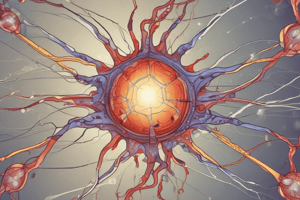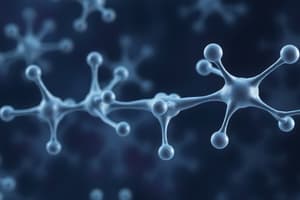Podcast
Questions and Answers
What is the primary neurotransmitter that adrenergic receptors respond to?
What is the primary neurotransmitter that adrenergic receptors respond to?
- Acetylcholine
- Norepinephrine and epinephrine (correct)
- Serotonin
- Dopamine
Which type of adrenergic receptor is found in pancreatic islet cells and adipose tissue?
Which type of adrenergic receptor is found in pancreatic islet cells and adipose tissue?
- α2 (correct)
- α1
- β1
- β2
What is the effect of activating α1 receptors?
What is the effect of activating α1 receptors?
- Vasoconstriction and increased blood pressure (correct)
- Relaxation of smooth muscle
- Decreased blood pressure
- Increased insulin secretion
Which adrenergic receptor is involved in increased heart rate and contractility?
Which adrenergic receptor is involved in increased heart rate and contractility?
What is the effect of activating β2 receptors?
What is the effect of activating β2 receptors?
Which type of adrenergic agonist increases the release of norepinephrine?
Which type of adrenergic agonist increases the release of norepinephrine?
What is the clinical application of adrenergic agonists?
What is the clinical application of adrenergic agonists?
What is the clinical application of beta blockers?
What is the clinical application of beta blockers?
Flashcards are hidden until you start studying
Study Notes
Adrenergic Receptors
- Also known as adrenoceptors
- Respond to the neurotransmitter norepinephrine (NE) and epinephrine (E)
- Two main categories: alpha (α) and beta (β) receptors
Alpha Receptors
- Further divided into two subtypes: α1 and α2
- α1 receptors:
- Found in smooth muscle and exocrine glands
- Activation causes vasoconstriction, increased blood pressure, and pupil dilation
- α2 receptors:
- Found in pancreatic islet cells, adipose tissue, and some neurons
- Activation causes decreased insulin secretion, increased glucagon secretion, and decreased lipolysis
Beta Receptors
- Further divided into three subtypes: β1, β2, and β3
- β1 receptors:
- Found in heart and kidney
- Activation causes increased heart rate, contractility, and renin secretion
- β2 receptors:
- Found in smooth muscle, skeletal muscle, and liver
- Activation causes relaxation of smooth muscle, increased muscle contraction, and increased glycogenolysis
- β3 receptors:
- Found in adipose tissue
- Activation causes increased lipolysis
Adrenergic Agonists
- Direct-acting agonists:
- Stimulate adrenergic receptors directly
- Examples: norepinephrine, epinephrine, isoproterenol, and phenylephrine
- Indirect-acting agonists:
- Increase the release or inhibit the reuptake of norepinephrine
- Examples: amphetamine and cocaine
Adrenergic Antagonists
- Alpha blockers:
- Block α receptors
- Examples: phentolamine and prazosin
- Beta blockers:
- Block β receptors
- Examples: propranolol and atenolol
Clinical Applications
- Adrenergic agonists:
- Used to treat anaphylaxis, asthma, and hypotension
- Used as decongestants and in ophthalmology
- Adrenergic antagonists:
- Used to treat hypertension, anxiety, and glaucoma
- Used in cardiology to reduce heart rate and blood pressure
Adrenergic Receptors
- Respond to neurotransmitters norepinephrine (NE) and epinephrine (E)
- Classified into two main categories: alpha (α) and beta (β) receptors
Alpha Receptors
- Divided into two subtypes: α1 and α2
- α1 receptors:
- Found in smooth muscle and exocrine glands
- Activation causes vasoconstriction, increased blood pressure, and pupil dilation
- α2 receptors:
- Found in pancreatic islet cells, adipose tissue, and some neurons
- Activation causes decreased insulin secretion, increased glucagon secretion, and decreased lipolysis
Beta Receptors
- Divided into three subtypes: β1, β2, and β3
- β1 receptors:
- Found in heart and kidney
- Activation causes increased heart rate, contractility, and renin secretion
- β2 receptors:
- Found in smooth muscle, skeletal muscle, and liver
- Activation causes relaxation of smooth muscle, increased muscle contraction, and increased glycogenolysis
- β3 receptors:
- Found in adipose tissue
- Activation causes increased lipolysis
Adrenergic Agonists
- Direct-acting agonists:
- Stimulate adrenergic receptors directly
- Examples: norepinephrine, epinephrine, isoproterenol, and phenylephrine
- Indirect-acting agonists:
- Increase the release or inhibit the reuptake of norepinephrine
- Examples: amphetamine and cocaine
Adrenergic Antagonists
- Alpha blockers:
- Block α receptors
- Examples: phentolamine and prazosin
- Beta blockers:
- Block β receptors
- Examples: propranolol and atenolol
Clinical Applications
- Adrenergic agonists:
- Used to treat anaphylaxis, asthma, and hypotension
- Used as decongestants and in ophthalmology
- Adrenergic antagonists:
- Used to treat hypertension, anxiety, and glaucoma
- Used in cardiology to reduce heart rate and blood pressure
Studying That Suits You
Use AI to generate personalized quizzes and flashcards to suit your learning preferences.





